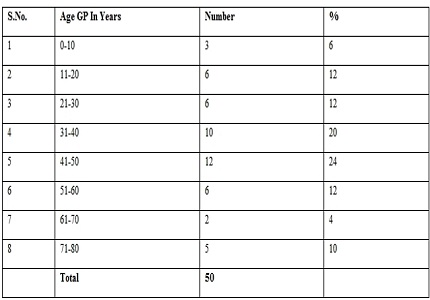A study of fungal corneal ulcer
Abstract
Background: Fungal keratitis is an inflammation of the cornea caused by fungi. This infection is difficult to treat and it can lead to severe visual impairment or blindness. It is worldwide in distribution, but is more common in the tropics and subtropical regions. Corneal ulcers are the second most-common cause of preventable blindness after cataract in tropical developing countries.
Material & Methods: A retrospective study included 30 cases of fungal corneal ulcer was carried out on indoor and outdoor cases of fungal corneal ulcer, in Department of ophthalmology, in technical collaboration with department of microbiology in tertiary care teaching hospital. A presumptive diagnosis was based on clinical features and history, diagnosis was confirmed by KOH preparation and culture.
Results: The maximum incidence of ulcers was seen in age group of 41-60 years and majority of them were males. Most common predisposing factor was trauma. Most common clinical feature was slough followed by hypopyon, perforation, lowered intraocular tension, satellite lesions and vascularization respectively.
Conclusion: The diagnosis of fungal keratitis is usually difficult. The clinical suspicion by ophthalmologist is unequivocally, key element in making diagnosis of fungal infection of cornea. A wide range of conventional and molecular techniques are currently available for laboratory diagnosis of fungal keratitis. Early diagnosis and appropriate treatment are essential to avoid blindness.
Downloads
References
2. Gopinathan U, Sharma S, Garg P, Rao GN. Review of epidemiological features, microbiological diagnosis and treatment outcome of microbial keratitis: experience of over a decade. Indian J Ophthalmol.2009;57:273–279. [PubMed]
3. Iyer SA, Tuli SS, Wagoner RC. Fungal keratitis: emerging trends and treatment outcomes. Eye Contact Lens. 2006 Dec;32(6):267-71. [PubMed]
4. Gower EW, Keay LJ, Oechsler RA, Iovieno A, Alfonso EC, Jones DB, Colby K, Tuli SS, Patel SR, Lee SM, Irvine J, Stulting RD, Mauger TF, Schein OD. Trends in fungal keratitis in the United States, 2001 to 2007. Ophthalmology. 2010 Dec;117(12):2263-7. doi: 10.1016/j.ophtha.2010.03.048. Epub 2010 Jun 29.
5. Gopinathan U, Garg P, Fernandes M, Sharma S, Athmanathan S, Rao GN. The epidemiological features and laboratory results of fungal keratitis: a 10-year review at a referral eye care center in South India. Cornea. 2002 Aug;21(6):555-9.
6. Ritterband DC, Seedor JA, Shah MK, Koplin RS, McCormick SA. Fungal keratitis at the new york eye and ear infirmary. Cornea. 2006 Apr;25(3):264-7. [PubMed]
7. Levin LA, Avery R, Shore JW, Woog JJ, Baker AS. The spectrum of orbital aspergillosis: a clinicopathological review. Surv Ophthalmol. 1996 Sep-Oct;41(2):142-54. [PubMed]
8. Yohai RA, Bullock JD, Aziz AA, Markert RJ. Survival factors in rhino-orbital-cerebral mucormycosis. Surv Ophthalmol. 1994 Jul-Aug;39(1):3-22. [PubMed]
9. Srinivasan R, Kanungo R, Goyal JL. Spectrum of oculomycosis in South India. Acta Ophthalmol (Copenh). 1991 Dec;69(6):744-9. [PubMed]
10. Rao NA. A laboratory approach to rapid diagnosis of ocular infections and prospects for the future. Am J Ophthalmol. 1989 Mar 15;107(3):283-91. [PubMed]
11. Rosa RH Jr, Miller D, Alfonso EC. The changing spectrum of fungal keratitis in south Florida. Ophthalmology. 1994 Jun;101(6):1005-13. [PubMed]
12. Gopinathan, U., P. Garg, M. Fernandes, S. Sharma, S. Athmanathan, and G. N. Rao. 2002. The epidemiological features and laboratory results of fungal keratitis. A 10-year review at a referral eye care center in South India. Cornea 21:555-559. [PubMed]
13. Marcus L, Vismer HF, van der Hoven HJ, Gove E, Meewes P. Mycotic keratitis caused by Curvularia brachyspora (Boedjin). A report of the first case. Mycopathologia. 1992 Jul;119(1):29-33.
14. Sharma, S., M. Silverberg, P. Mehta, U. Gopinathan, V. Agrawal, and T. J. Naduvilath. 1998. Early diagnosis of mycotic keratitis: predictive value of potassium hydroxide preparation. Indian J. Ophthalmol. 46:31-35. [PubMed]
15. Wong TY, Ng TP, Fong KS, Tan DT. Risk factors and clinical outcomes between fungal and bacterial keratitis: a comparative study. CLAO J. 1997 Oct;23(4):275-81.
16. Xie L, Dong X, Shi W. Treatment of fungal keratitis by penetrating keratoplasty. Br J Ophthalmol. 2001 Sep;85(9):1070-4. [PubMed]
17. Zhu WS, Wojdyla K, Donlon K, Thomas PA, Eberle HI. Extracellular proteases of Aspergillus flavus. Fungal keratitis, proteases, and pathogenesis. Diagn Microbiol Infect Dis. 1990 Nov-Dec;13(6):491-7. [PubMed]
18. Thomas PA, Garrison RG, Jansen T. Intrahyphal hyphae in corneal tissue from a case of keratitis due to Lasiodiplodia theobromae. J Med Vet Mycol. 1991;29(4):263-7. [PubMed]
19. Srinivasan M, Gonzales CA, George C, Cevallos V, Mascarenhas JM, Asokan B, Wilkins J, Smolin G, Whitcher JP. Epidemiology and aetiological diagnosis of corneal ulceration in Madurai, south India. Br J Ophthalmol. 1997 Nov;81(11):965-71. [PubMed]
20. Sharma S,Athmanathan (2002). Diagnostic procedures in infectious keratitis. In; Nema H V, Nema N, editors. Diagnostic procedures in Ophthalmology.New Delhi: Jaypee Brothers Medical Publishers; 232-253.
21. Tuli SS. Fungal keratitis. ClinOphthalmol. 2011;5:275–9. doi: 10.2147/OPTH.S10819. [PubMed]
22. Thomas PA. Current perspectives on ophthalmic mycoses. Clin Microbiol Rev. 2003 Oct;16(4):730-97. [PubMed]
23.Dr Sharma K, DrMehtaSA profile of corneal ulcers – 2 years study from rural hospital, HaryanaIOSR Journal of Dental and Medical Sciences (IOSR-JDMS) e-ISSN: 2279-0853, p-ISSN: 2279-0861.Volume 13, Issue 11 Ver. VII (Nov. 2014), PP 94-97.www.iosrjournals.org
24.Katara RS, Patel ND, Sinha M. A Clinical Microbiological Study of Corneal Ulcer Patients at Western Gujarat, India.ActaMedicaIranica. 2013; 51(6):399-403. [PubMed]
25. Kumar A, Pandya S, Kavathia G, Antala S, Madan M, Javdekar T. Microbial keratitis in Gujarat, Western India: findings from 200 cases. Pan Afr Med J. 2011;10:48. Epub 2011 Nov 29. [PubMed]
26. Ibrahim MM, Vanini R, Ibrahim FM, Fioriti LS, Furlan EMR, Rovinzano LMA, De Castro RS, E Faria E Sousa SJ, Rocha EM. Epidemiologic aspects and clinical outcome of fungal keratitis in southeastern Brazil.E Journal Ophthalmol. 2009; 19(3):355-61.
27. Thomas PA, Leck AK, Myatt M. Characteristic clinical features as an aid to the diagnosis of suppurative keratitis caused by filamentous fungi. Br J Ophthalmol. 2005 Dec;89(12):1554-8.
28. Ho JW, Fernandez MM, Rebong RA, Carlson AN, Kim T, Afshari NA. Microbiological profiles of fungal keratitis: a 10-year study at a tertiary referral center. J Ophthalmic Inflamm Infect. 2016 Dec;6(1):5. doi: 10.1186/s12348-016-0071-6. Epub 2016 Feb 20.



 OAI - Open Archives Initiative
OAI - Open Archives Initiative


